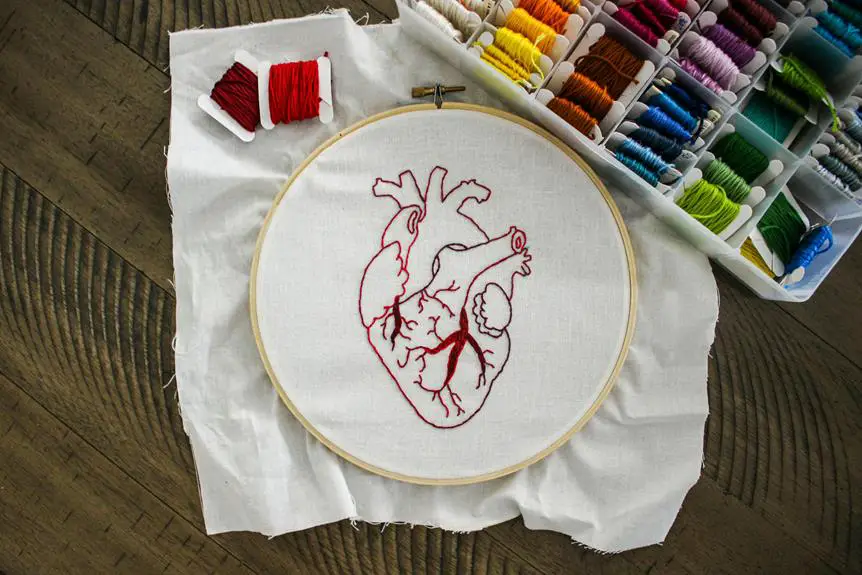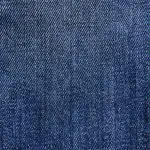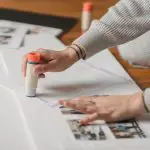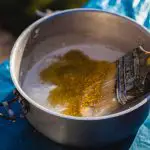When you're crafting with fabric and glue, choosing the right adhesive is crucial to your project's success. You'll want to consider the type of fabric and the specific requirements of your design before you start. Preparing your fabric properly and planning your design can make a significant difference in the final outcome. As you progress, you might find that experimenting with textures opens up new creative avenues. But remember, there are key techniques to master that can elevate your work even further, and it all starts with a few simple steps that can transform your crafting experience.
Table of Contents
Key Takeaways
- Choose the right glue based on fabric type; use fabric glue for lightweight materials and hot glue for heavier projects.
- Pre-wash and iron fabrics to ensure better adhesion by removing dirt and wrinkles before applying glue.
- Plan your design by sketching ideas and selecting a cohesive color palette to guide your project.
- Allow adequate drying time according to glue instructions to ensure strong bonds and durability in your crafts.
Choose the Right Glue
Choosing the right glue is crucial for ensuring your fabric crafts hold up beautifully over time. With so many options available, it can be overwhelming to decide which one suits your project best.
Start by considering the type of fabric you're using. For lightweight fabrics, a fabric glue or a water-based adhesive works wonders. If you're working with heavier materials, opt for a stronger adhesive, like a hot glue or a heavy-duty fabric glue.
Next, think about the finish you want. If you need a clear, flexible bond, a fabric glue is ideal, as it dries clear and remains pliable. For projects that require a quick hold, hot glue can be your best friend, but remember that it can be rigid once dried.
Also, don't forget about washability. If your fabric project will be washed frequently, choose a washable fabric glue. Always test a small area first to ensure the adhesive doesn't damage your fabric.
Prepare Your Fabric
Before you start your fabric crafts, it's vital to prepare your materials properly.
You'll want to choose appropriate fabrics, pre-wash and iron them, and cut your materials precisely to ensure a great result.
Taking these steps will set a solid foundation for your project.
Choose Appropriate Fabrics
When getting ready for your fabric crafts, it's essential to pick fabrics that bond well with glue and suit your project's needs. The right fabric can make a significant difference in the success of your craft, so take some time to consider your options.
Here are three types of fabrics that generally work well with glue:
- Cotton: This natural fiber is versatile and easy to work with, making it a great choice for various projects. It absorbs glue well, ensuring a strong bond.
- Felt: Felt comes in a variety of colors and thicknesses. Its non-fraying edges and rigid structure make it ideal for crafts where you want clean lines and shapes.
- Denim: For a sturdy and durable option, denim is fantastic. It holds up well under stress and can be glued for both decorative and functional projects.
Always think about the look and feel you want to achieve. Choosing the right fabric not only enhances the final result but also simplifies the crafting process.
Make the best choices, and you'll see your projects come to life!
Pre-wash and Iron
Preparing your fabric by pre-washing and ironing helps ensure that it's clean and smooth, allowing for better adhesion when you apply glue.
Start by checking the fabric's care label for washing instructions. If it's machine washable, toss it in the washer with a mild detergent. This step removes any dirt, dust, or chemicals that may interfere with the glue's effectiveness.
Once washed, dry the fabric according to the label's instructions. You can either air dry or tumble dry, but make sure it's completely dry before moving on to the next step.
Next, grab your iron. Set it to the appropriate temperature for your fabric type—high for cotton, low for synthetics. Ironing smooths out wrinkles and creases, creating a flat surface for your glue application.
Make sure to iron both sides of the fabric for the best results.
Cut Materials Precisely
To achieve clean edges and a professional finish, measure and cut your fabric carefully using sharp scissors or a rotary cutter.
Precise cutting not only enhances the appearance of your project but also ensures that pieces fit together seamlessly.
Here are some tips to help you cut materials accurately:
- Use a Cutting Mat: Lay your fabric on a self-healing cutting mat. This protects your surfaces and provides a grid for accurate measurements.
- Align the Fabric: Make sure the fabric is straight and aligned. Use the edges of the fabric as a guide, and consider using fabric weights or pins to keep it in place.
- Mark Your Cut Lines: Before cutting, mark your measurements lightly with tailor's chalk or a fabric pen. This gives you a clear line to follow and reduces the chance of errors.
Plan Your Design
Before diving into your fabric crafts, sketch out your design to visualize how the elements will come together. This step is crucial for ensuring that your ideas translate well onto the fabric. Start by choosing a theme or concept that inspires you. Whether it's a floral pattern, geometric shapes, or whimsical characters, having a clear idea will guide your creative process.
Next, consider the colors and textures of the fabrics you've cut. Make a color palette by placing swatches next to each other to see how they interact. This will help you achieve a harmonious look. Don't forget about scale: think about how large or small each piece should be in relation to the entire project.
Once you've got your color and texture in mind, map out where each element will go. This doesn't have to be intricate; simple outlines will do. Your sketch will serve as a roadmap, helping you stay organized as you work.
With a well-planned design, you'll find that the crafting process becomes smoother, allowing you to focus on bringing your vision to life with glue and fabric!
Use Proper Techniques
To get the best results in your fabric crafts, you need to choose the right glue for your project.
Mastering application techniques will also make a big difference in how your creations turn out.
Let's explore these essential points to elevate your crafting skills.
Choose the Right Glue
Choosing the right glue is crucial for achieving strong, lasting bonds in your fabric crafts. With so many options on the market, knowing which type to use can make a significant difference in your project's outcome. Here are three essential types of glue you should consider:
- Fabric Glue: Specifically designed for fabric, this type offers flexibility and durability. It dries clear and is washable, making it perfect for wearable crafts or items that may see regular use.
- Hot Glue: Ideal for quick fixes and temporary bonds, hot glue is excellent for attaching embellishments or creating 3D elements. However, it can become brittle over time, so it's best for projects that won't be washed frequently.
- PVA Glue (White School Glue): This versatile glue works well for light fabrics and paper. It's non-toxic and dries clear, but it's not as strong as fabric glue, so reserve it for lighter projects.
Master Application Techniques
Mastering application techniques is essential for achieving neat and durable results in your fabric crafts. Start by preparing your workspace and materials. Lay down a protective surface to catch any excess glue and keep everything organized.
When applying glue, use a fine-tip applicator for precision, especially in intricate designs. This helps you control the amount of glue you use, preventing over-saturation of the fabric. Always apply glue in thin, even layers. Thick layers can lead to wrinkling or bubbling, ruining your project.
If you're layering fabrics, allow each layer to dry completely before adding the next. This ensures a strong bond and maintains the fabric's integrity.
Don't forget to practice patience. Rushing through your project can lead to mistakes. Take your time to place materials accurately, and don't hesitate to adjust if something doesn't look right.
For added durability, consider using clamps or weights to hold pieces together while the glue sets.
Experiment With Textures
Experimenting with textures can elevate your fabric crafts, giving them a unique and dynamic appeal. By incorporating different materials and techniques, you can create eye-catching projects that stand out. Here are three ways to enhance your textures:
- Layering Fabrics: Combine various fabric types, like cotton, burlap, and lace. Layering adds depth and visual interest, making your project more intriguing.
- Using Embellishments: Incorporate items like buttons, sequins, or beads. These small additions can break up flat surfaces and introduce new textures that catch the light and draw attention.
- Mixing Techniques: Experiment with different gluing methods, like using a glue gun for a raised effect or fabric glue for a flat finish. This variety can transform your piece, adding complexity and dimension.
As you play with these techniques, don't be afraid to think outside the box. A little creativity can lead to stunning results.
Allow for Drying Time
Allowing your fabric crafts to dry properly is crucial for ensuring that the glue sets securely and your project maintains its intended shape and durability. Rushing this step can lead to a weak bond and may cause your pieces to fall apart when you least expect it. After applying glue, make sure to set your project aside in a stable, dry area.
Check the glue's instructions for recommended drying times, as they can vary based on the type of glue used. Some glues may require only a few hours, while others might need overnight to cure fully. If you're working on layered projects, allow each layer to dry completely before adding the next. This not only strengthens the overall design but also prevents any mess that could result from wet glue seeping through layers.
Keep an eye on your project during the drying process, and avoid touching or moving it until it's fully set. If you're in a hurry, consider using a fan or a warm, dry room to speed up the drying time. However, be careful not to use excessive heat, as it can warp your fabric or alter the glue's effectiveness.
Clean Up Effectively
Once your fabric crafts are dry, it's time to tackle the clean-up to keep your workspace organized and free of glue residue. A clean environment not only helps maintain your creativity but also makes future projects easier.
Here's how to effectively clean up after your crafting session:
- Gather Supplies: Collect all the materials you used, including fabric scraps, glue tubes, and tools. Having everything in one spot will streamline your clean-up process.
- Wipe Surfaces: Use a damp cloth or paper towel to wipe down your workspace. If you've got stubborn glue spots, try using a bit of rubbing alcohol on a cotton ball to lift them away. Just be careful with the surfaces you're cleaning!
- Dispose Properly: Throw away any scraps and empty glue containers in the trash. If you used recyclable materials, make sure to separate them for proper recycling.
Frequently Asked Questions
Can I Use Fabric Glue on All Types of Fabric?
You can use fabric glue on many types of fabric, but some materials like leather or silk may not bond well. Always check the glue's label to ensure it's suitable for your specific fabric choice.
How Do I Remove Dried Glue From Fabric?
To remove dried glue from fabric, gently scrape off excess with a blunt knife. Then, apply rubbing alcohol or vinegar to the area, blot with a cloth, and rinse with cold water to finish.
Are There Any Fabric Glues That Are Waterproof?
Yes, there are waterproof fabric glues available. Look for brands specifically labeled as waterproof or water-resistant. These glues bond well and withstand moisture, making them ideal for outdoor projects or items that may get wet.
Can I Wash Fabric Crafts Made With Glue?
You can wash fabric crafts made with glue, but it's best to check the glue's instructions first. Some glues resist water, while others might not hold up well in the washing machine.
What Safety Precautions Should I Take When Using Fabric Glue?
When using fabric glue, always work in a well-ventilated area, wear gloves to protect your skin, and avoid eye contact. Read the label for specific warnings, and keep it out of reach of children.
- What Is Pochampally Ikat? a Journey to India’s Silk City - June 27, 2025
- What Is Pochampally Ikat? a Journey to India’s Silk City - June 27, 2025
- What Is Pochampally Ikat? a Journey to India’s Silk City - June 27, 2025






